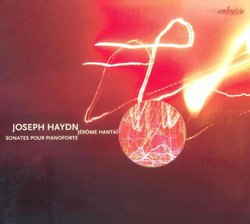| All Artists: Haydn, Hantai Title: Piano Sonatas Members Wishing: 0 Total Copies: 0 Label: Ambroisie Original Release Date: 1/1/2005 Re-Release Date: 7/12/2005 Album Type: Import Genre: Classical Styles: Chamber Music, Forms & Genres, Sonatas, Historical Periods, Classical (c.1770-1830) Number of Discs: 1 SwapaCD Credits: 1 UPC: 3760020170752 |
Search - Haydn, Hantai :: Piano Sonatas
 | Haydn, Hantai Piano Sonatas Genre: Classical
|
Larger Image |
CD Details |
CD ReviewsJerome Hantai Plays Haydn Piano Sonatas Robin Friedman | Washington, D.C. United States | 02/20/2008 (5 out of 5 stars) "Jerome Hantai has enjoyed an enviable career as a performer of early music, on the viola de gamba, the keyboard, and as part of his own group, the Jerome Hantai ensemble. In this CD, recorded in 2005, Hantai offers a program of six Haydn sonatas performed on a fortepiano. Hantai uses a historical instrument built by Pierre Taskin, a maker of harpsichords, in about 1788. The 62-note instrument was restored in 1973 and is the property of the Musee du Louvre, Paris.
The Taskin fortepiano and Hantai's playing make a beautiful way to explore the Haydn sonatas. The fortepiano has a dry, detached and clear sound. Even though the mechanism involves striking rather than plucking the strings, the instrument sounds as much like a harpsichord as a piano. But it is capable of dynamic gradations, and Hantai makes the most of them. He offers an idiomatic and convincing period instrument reading of Haydn. In listening to this recording, I was reminded of Hamelin's highly-acclaimed two-volume set of ten Haydn sonatas on Hyperion. Hamelin plays with great virtuosity on a modern concert grand. His performing style and the difference in instruments invite much comparing and contrasting to Hantai's reading. Together, the two recordings include 15 different works, as only the sonata in A-flat major, Hob: 46 appears on both CDs. Both Hamelin and Hantai offer a cross-section of Haydn's solo keyboard sonatas. But on the whole Hantai's selections date from earlier in his career. Hantai includes one early work, the sonata in B major, Hob. 2 while the remaining five works date roughly from Haydn's middle period. Hamelin's recital includes no early works and two of Haydn's late masterworks. These late works, written when Haydn was visiting in London are more appropriately performed on a modern instrument. Together, these two recordings offer an excellent overview of the Haydn sonatas and of different approaches, a modern and a period approach, to their performance. Haydn's sonatas, for too long slighted, show his inventiveness and creativity no less than do his symphonies and string quartets. The earliest work on this CD, the three movement B major sonata, dates from about 1760 and features a tragic slow movement, highly passionate for a work of this time. Both Hantai and Hamelin offer a single minor-key work in their recitals. Hantai's is the two movement sonata in G minor Hob 44 which dates from 1771 -- 1773. The lengthy and hard-edged opening movement is a work of Sturm und Drang with its shifts in tempo, dramatic pauses, and plunging downward runs. The two-movement sonata in B-flat major, Hob 18, also dates from this period and is in the intimate style of chamber music. The largest-scale work on this CD, also performed by Hamelin, is the three-movement sonata in B-flat major, Hob 46. This sonata is a work of contrasts, harmonic adventurousness, and dramatic shifts. It features a lovely, poignant slow movement and a short concluding presto. This excellent sonata works both for a virtuoso performance under Hamelin's hands and in its period rendition with Hantai. The three-movement sonata in E-flat major, Hob 28 opens with a movement consisting of one primary theme and many episodes which vary the theme by changing tempo and by intricate series of runs and arpeggios. The second movement is a minuet which moves several times from the major to the minor key. The work concludes with a rapid-fire set of variations. A second work on the program in E-flat major, Hob 25, consists of two movements the first of which, as are many of Haydn's opening movements, is marked moderato rather than allegro. The work opens with large, foreboding chords, and much of the music is in the minor key. The sonata concludes with a spare highly syncopated canon. The CD includes informative liner notes, Hantai's commentary on the sonatas, and a good description of the Taskin fortepiano. Robin Friedman " |

 Track Listings (15) - Disc #1
Track Listings (15) - Disc #1